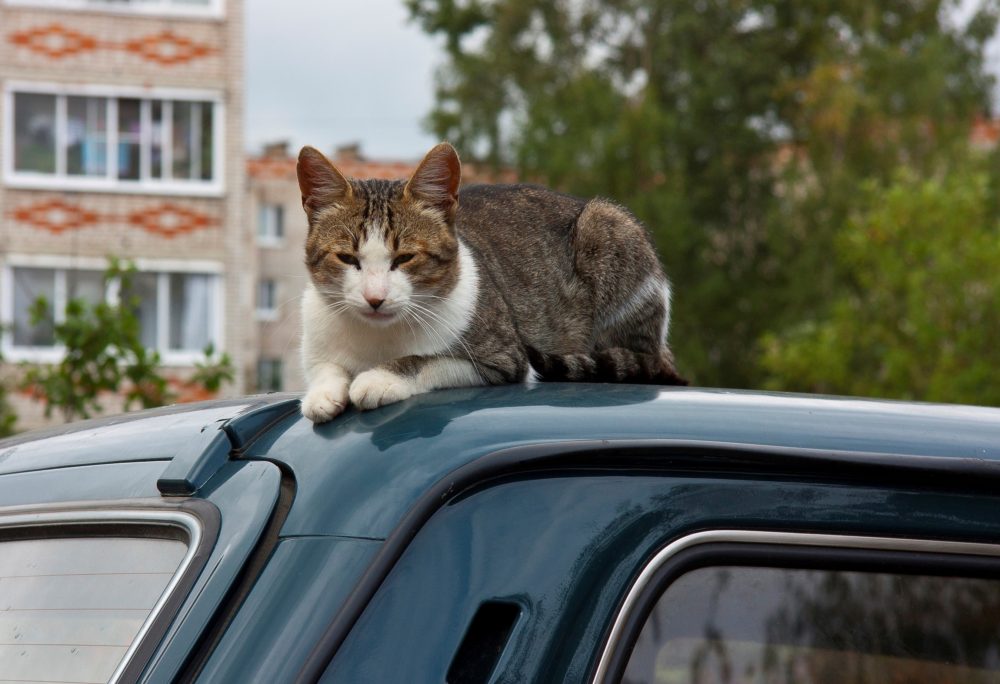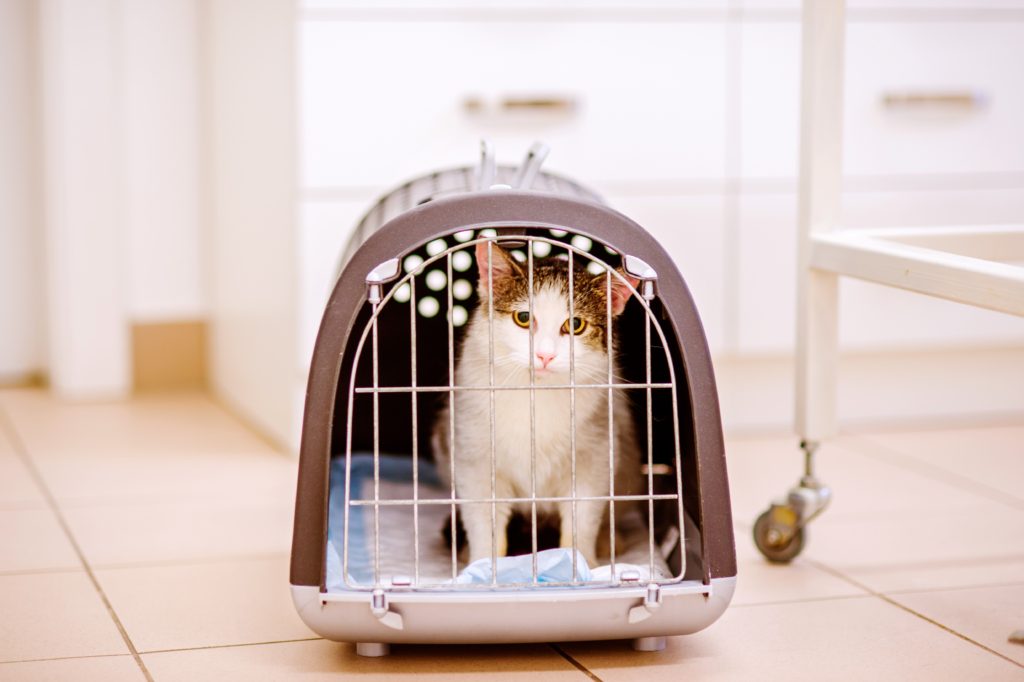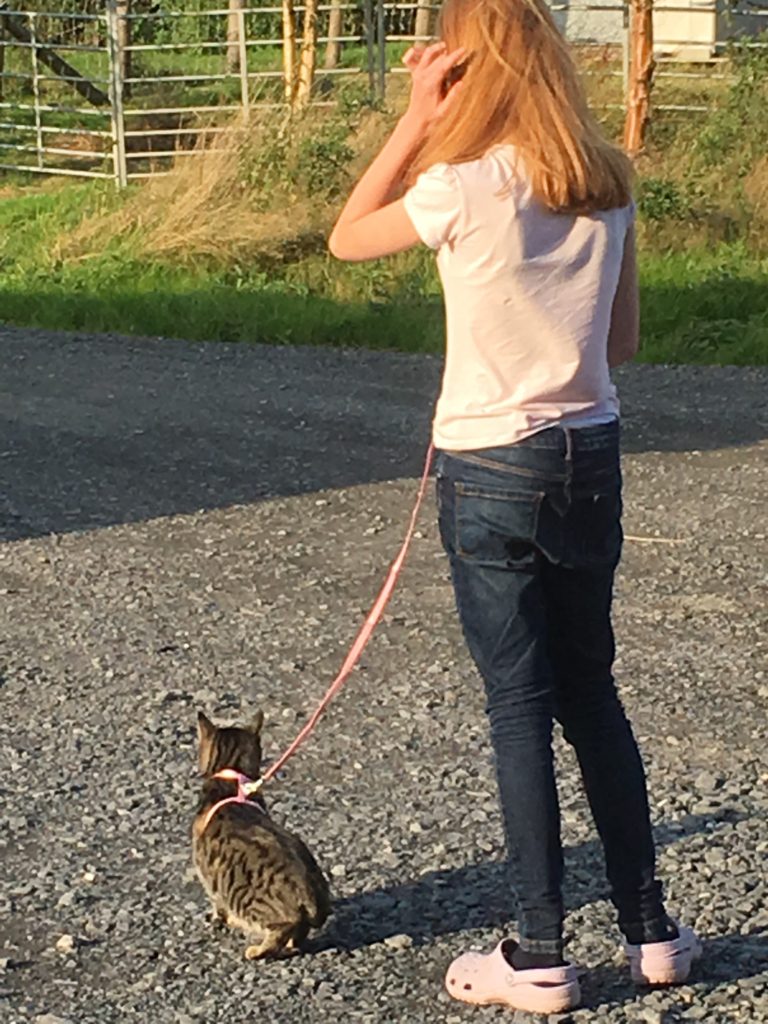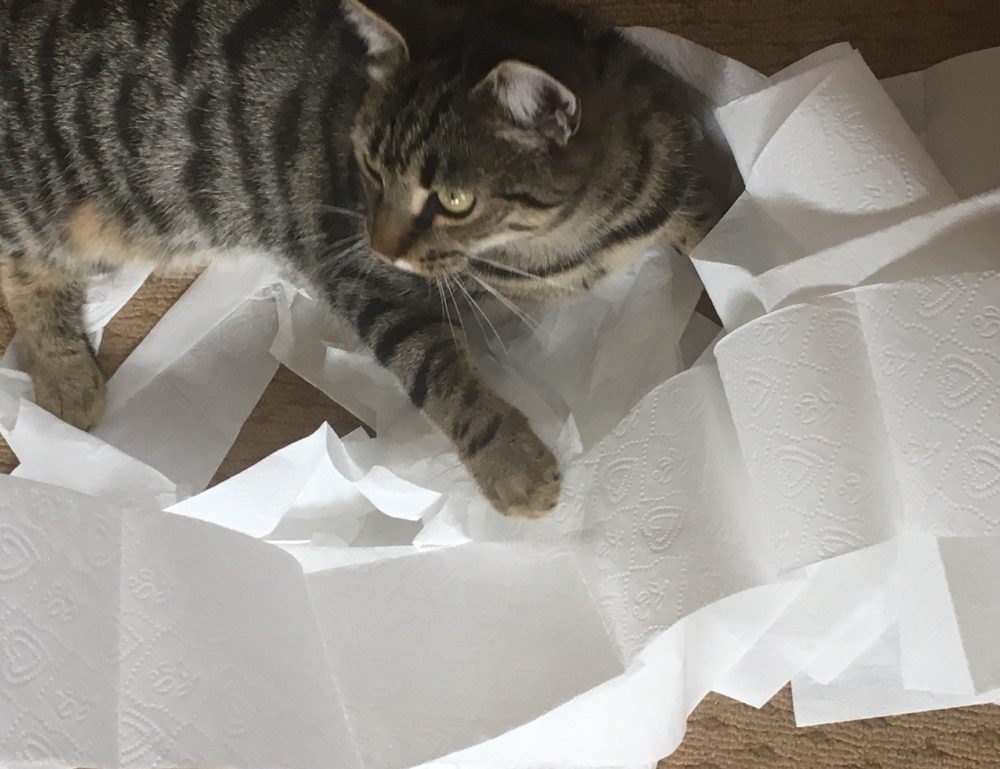
Tips for travelling with your cat – by car, train, bus or plane
Unlike us humans’ cats do not get excited at the prospect of a trip away or a fun holiday, therefore unless circumstances dictate otherwise your cat would probably prefer to stay at home in the comfort of their familiar environment. Getting a friend or neighbour to cat-sit while you are away will be less stressful for your cat. They like routine, the safety of their home surroundings and tend to get stressed with any major changes. But, if leaving your cat at home is not an option, or you are moving home and have a one-way trip coming up for your cat, then preparation is key to ensure the journey is as comfortable as possible, for you and your cat. This will help associate travelling as a happy, positive experience. Be patient in preparing your kitty for this upcoming trip and take your time.
Preparing for travelling in the car with your cat
Buying a suitable cat carrier
 This is a key factor in preparation of the journey ahead. It is not an option to travel without a cat carrier. A cat loose in the car can be very dangerous – distracting the driver, getting under the pedals or escaping through an open window onto the road could all cause an accident. The carrier will need to be strong, secure, easy to clean and large enough for your cat. For long journeys, the carrier will need to accommodate food and water bowls, ideally ones that can be secured to the sides of the carrier. It will also be important that your cat has room to stretch and turn around in the carrier on long journeys. This needs to be balanced with the fact that cats usually feel more secure in a snug cosy space. A carrier approximately twice the size of your cat is a good guideline.
This is a key factor in preparation of the journey ahead. It is not an option to travel without a cat carrier. A cat loose in the car can be very dangerous – distracting the driver, getting under the pedals or escaping through an open window onto the road could all cause an accident. The carrier will need to be strong, secure, easy to clean and large enough for your cat. For long journeys, the carrier will need to accommodate food and water bowls, ideally ones that can be secured to the sides of the carrier. It will also be important that your cat has room to stretch and turn around in the carrier on long journeys. This needs to be balanced with the fact that cats usually feel more secure in a snug cosy space. A carrier approximately twice the size of your cat is a good guideline.
If travelling with more than one cat, then you will need a much larger crate assuming they get on well enough to travel together. If not, or if it’s a long journey, place in separate carriers but ensure they can see each other Carriers can be made of whicker, plastic, fibre-glass or wire mesh. Cardboard carriers or light plastic boxes are best avoided for long journeys. There are soft sided and hard sided carriers. Take time to research the various carriers available and invest in a safe and durable carrier. It will make travelling on long, and short, journeys so much more comfortable and less stressful if your cat is happy in its carrier.
Get your cat used to the cat carrier
It is very likely that just putting your cat into its carrier for the first time ever on the day of the journey will result in anxiety and distress for your cat. Let them get used to the carrier well in advance, days or even weeks ahead of the journey if possible. Start by leaving the carrier on the floor and open, so they can start exploring and investigating it. Make the carrier a pleasant place to be – put your cat’s favourite treats in the carrier, make it comfortable and familiar by placing one of their favorite blankets inside.
Make a few short trips before embarking on a longer journey
Introduce your cat to car travel with a few short trips initially. Use the travel cage you will use on your trip to get them used to the smell, the motion etc. Even better if this can be done whist they are still young. They may be a great deal of meowing initially but hopefully should settle as the familiarity of car trips increases. Reward your cat with attention and treats after these short journeys so that they associate travelling with a positive vibe.
Speak to your vet if your cat is particularly nervous or travel sick
If your cat seems particularly distressed or is prone to travel sickness your vet will be able to advise if any medication id required. For a natural alternative to sedatives, try Bach Flower Essence ‘Rescue remedy’, it helps with fears and stresses. Simply put a few drops in your cat’s water before the journey and it should help them become calm and quiet.
Purchase a harness and lead
If your cat is used to a harness and lead, on long journeys it will be useful to be able to stop and let your cat have a little stroll and fresh air without the risk of escape! A harness is also useful for identification – your details will be easily accessible if clearly marked on the harness. Get your cat used to wearing the harness and taking walks on a lead for a few days or weeks before your journey.
Tips for travelling in the car with your cat
On the day of travelling the following tips will help to ensure all goes as smoothly as possible, and even be an enjoyable trip.
Do not feed your cat 2-3 hours before travelling
A tummy full of food could trigger travel sickness which would make the journey more stressful for you and your cat.
Ensure the cat carrier is located securely in the car
Ideally, the carrier is strapped in place with a seat belt. If this is not possible, the carrier can be secured with cords or ropes – in the event of the car having to break suddenly the carrier would be secure. The carrier needs to be located where there is good air flow and ventilation – not underneath other luggage!
Put your cat’s favorite blanket or towel in the carrier
 The familiar smells will be comforting to your cat. Add their favorite toy into the carrier too.
The familiar smells will be comforting to your cat. Add their favorite toy into the carrier too.
Carry supplies of plastic bags, paper towels and pet safe cleaner
Hopefully they won’t be needed but always better to be prepared.
Spray the inside of the carrier with pheromones 20 minutes before travelling
Pheromone sprays or diffusers can help to calm your cat. Pheromones are chemicals that the body releases when a cat is happy or sad to communicate with other cats and the outside world. For example, when cats rub against their owners, or furniture, they are leaving a small portion of this pheromone behind. This can be detected by other animals and used to mark territory. Some diffusers / sprays contain calming pheromones which will help your cat feel at ease. Always test your cat’s reaction to the spray prior to travelling.
Open the car window a little to let fresh air in
This is especially important on warm days.
Check car temperature
Ensure the car doesn’t get too hot or too cold. Cars can heat up very quickly, even on relatively mild days. If you stop for a break, ensure the car is parked in the shade and leave the windows open. On very hot days it is best to take your cat with you out of the car, in its carrier. Ice packs or frozen water bottle wrapped in a towel or cloth can be placed in the carrier to keep your cat cool on very hot days. Cats can overheat quickly, and heat stroke can kill so it is very important to monitor the temperature on hot days. Likewise, if travelling in winter, pack a few extra blankets for your cat.
Somewhere to hide
Cats like to hide especially if feeling uncertain so if your carrier is made of wire it may be help if part of it is covered with a blanket or towel.
Use a cat harness and lead
 This can be particularly useful on long journeys. You can then take our cat for a little stroll stretch its legs and have some fresh air safe in the knowledge that he can’t run away. This can be a great opportunity too to offer use of the litterbox. A harness and lead are also much easier to grab hold of should your cat try to escape.
This can be particularly useful on long journeys. You can then take our cat for a little stroll stretch its legs and have some fresh air safe in the knowledge that he can’t run away. This can be a great opportunity too to offer use of the litterbox. A harness and lead are also much easier to grab hold of should your cat try to escape.
Make sure your cat is wearing ID of some kind
Your name, address and telephone number should be on your cat’s collar or harness making it easy to find you should your cat accidentally escape. This is in addition to a microchip – a trip to the vet or an animal shelter would be required if someone need to retrieve your information from a microchip.
Check your cat regularly
Speaking in a calm reassuring voice will be a comfort to your cat. Do not let your cat out of the carrier until you have arrived at your destination unless it’s a scheduled stop when you are equipped and ready to use the harness and lead. Even if your cat is meowing throughout the journey, it is still safer in its carrier. Hopefully the motion of the car and the humming of the engine in addition to your preparation for this trip, will mean your cat will soon settle down.
Arrival at destination
Once you have arrived at your destination, whether a holiday home or your new house, give your cat time to get used to the new location. Keep them confined to one room, somewhere calm and quiet away from the business of unpacking. Check on them regularly, giving reassurance and attention.
Tips for travelling on the train or bus with your cat
 As with travelling in a car, preparation is key. Keeping your cat safe and secure is the priority when travelling on public transport. Most of the tips detailed above when travelling by car will be useful but bear in mind these additional tips specifically for public transport:
As with travelling in a car, preparation is key. Keeping your cat safe and secure is the priority when travelling on public transport. Most of the tips detailed above when travelling by car will be useful but bear in mind these additional tips specifically for public transport:
- Check if pets are allowed on the journey.
- Enquire before the journey if an additional ticket will be required for your cat.
- If possible avoid travelling at the busiest times.
- When selecting your carrier bear in mind the following:
- Can you carry the carrier – and your cat in it? Carriers with handles at both ends may ensure it doesn’t swing around too much as you carry it. A carrier on wheels may be an option if carrying your cat in its carrier is difficult or heavy.
- The carrier needs to be extra secure with no chance of your cat escaping.
- Line the carrier with absorbent liners.
- Take a blanket or towel to cover the carrier at least until you are settles on the train. This will make your cat feel safer.
- Ensure plenty of time to arrive at the station, running around in a blind panic at whether you will catch the train will most certainly upset the calmest kitty!
- Position your cat carrier on the bus or train where it can see and smell you such as underneath the seat in front of you.
- Be aware of other passengers, children may be attracted to your cat and want to say hello. A lot of attention may unsettle your already nervous pet.
Tips for travelling on a plane with your cat
 Travelling by plane with your cat will require thorough, well prepared planning and organisation. You will need to check all the details with your airline company beforehand but here are a few key tips:
Travelling by plane with your cat will require thorough, well prepared planning and organisation. You will need to check all the details with your airline company beforehand but here are a few key tips:
- Check with your airline if cats are allowed on the plane. Some flights are not licenced to carry animals. If an airline does allow cats, then familiarise yourself with their pet transportation policy. Be aware that rules and regulations can change often and vary from one company to another. Different rules may also apply to various countries. In depth research beforehand is essential.
- It is unlikely that your cat will be allowed to travel in the cabin with you, most pets are transported in a separate hold area of the plane (although there are some that do allow pets in cabin travel).
- It is best to confirm with the airline if they have specific requirements regarding the carrier in terms of its size and security. Key features to consider when purchasing the carrier, in addition to the specific airline’s own requirements, include:
- Good ventilation
- Secure – zips closing carriers are great for secure closing
- Waterproof base
- Size of carrier – if the cat will be in the cabin with you there will be restrictions on the size of the carrier similar to hand luggage. This can vary with different airline companies.
- Room for your pet to be able to stand up and turn around in the carrier
- Comfort – your car needs to be able to get comfortable in order to rest and sleep during the flight.
- Ensure that all the vaccination and health certificates are with you. It is useful to have one copy with you and one copy securely taped to the carrier. It is a good idea to visit your vet before the trip to ensure your cat is fit and healthy for flying.
- Allow plenty of time on the day of the journey. Checking in and additional checks for your cat take time, keeping calm yourself without the stress of rushing will benefit both you and your cat.
- Airports are noisy places, not only the noise of the planes but the general hustle and bustle of airports. Acclimatize your cat to loud noises beforehand if you can. Even better if you can visit the airport itself in advance.
- Respect other passengers. Some people may not be keen, or even afraid of cats or have an allergy. Your cat may also not be keen on too much attention from fellow passengers.
- Have plenty of treats and dry food to hand. Although it is best for your cat to travel on an empty stomach, if there are delays or it is a particularly long journey then a few nibbles will keep her going.
- It is not recommended to travel with a pregnant cat or new-born kittens. Contact your veterinary for further advice.
- Having arrived at your destination, allow your cat some time to de-stress and familiarize herself with her new surroundings. A quiet room with some dry food and some water and she should be back to her happy self in no time.
Travelling outside your own country
If you are taking your cat from one country to another it is essential to check all the various regulations. Pet passports, health requirements such as rabies vaccination and periods of quarantine will vary by country. Failure to comply may mean the cat not permitted to continue with the journey and it may be at greater risk of catching diseases it is not familiar with. Allow plenty of time to do all the necessary research and preparation.
Travelling with your cat, be it by car, train or plane, will require careful, organised planning. The more prepared you and your cat are, the better the experience will be for the both of you.
Other articles you may find of interest:
Bach Rescue Remedy for Cats – and other useful Flower remedies for cats
Do indoor cats need outside time? Why does my cat refuse to go outside?
Why do cats meow? Cat communication – a complete guide




